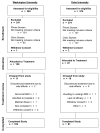Support for the vascular depression hypothesis in late-life depression: results of a 2-site, prospective, antidepressant treatment trial
- PMID: 20194828
- PMCID: PMC2838210
- DOI: 10.1001/archgenpsychiatry.2009.204
Support for the vascular depression hypothesis in late-life depression: results of a 2-site, prospective, antidepressant treatment trial
Erratum in
- Arch Gen Psychiatry. 2010 Oct;67(10):1043. Welsh-Boehmer, Kathleen [corrected to Welsh-Bohmer, Kathleen]
Abstract
Context: Research on vascular depression has used 2 approaches to subtype late-life depression, based on executive dysfunction or white matter hyperintensity severity.
Objective: To evaluate the relationship of neuropsychological performance and white matter hyperintensity with clinical response in late-life depression.
Design: Two-site, prospective, nonrandomized controlled trial.
Setting: Outpatient clinics at Washington University and Duke University.
Participants: A total of 217 subjects aged 60 years or older met DSM-IV criteria for major depression, scored 20 or more on the Montgomery-Asberg Depression Rating Scale (MADRS), and received vascular risk factor scores, neuropsychological testing, and magnetic resonance imaging; they were excluded for cognitive impairment or severe medical disorders. Fazekas rating was conducted to grade white matter hyperintensity lesions. Intervention Twelve weeks of sertraline treatment, titrated by clinical response. Main Outcome Measure Participants' MADRS scores over time.
Results: Baseline neuropsychological factor scores correlated negatively with baseline Fazekas scores. A mixed model examined effects of predictor variables on MADRS scores over time. Baseline episodic memory (P = .002), language (P = .007), working memory (P = .01), processing speed (P < .001), executive function factor scores (P = .002), and categorical Fazekas ratings (P = .05) predicted MADRS scores, controlling for age, education, age of onset, and race. Controlling for baseline MADRS scores, these factors remained significant predictors of decrease in MADRS scores, except for working memory and Fazekas ratings. Thirty-three percent of subjects achieved remission (MADRS < or =7). Remitters differed from nonremitters in baseline cognitive processing speed, executive function, language, episodic memory, and vascular risk factor scores.
Conclusions: Comprehensive neuropsychological function and white matter hyperintensity severity predicted MADRS scores prospectively over a 12-week treatment course with selective serotonin reuptake inhibitors in late-life depression. Baseline neuropsychological function differentiated remitters from nonremitters and predicted time to remission in a proportional hazards model. Predictor variables correlated highly with vascular risk factor severity. These data support the vascular depression hypothesis and highlight the importance of linking subtypes based on neuropsychological function and white matter integrity.
Trial registration: clinicaltrials.gov Identifier: NCT00045773.
Figures


References
-
- Carney R, Blumenthal J, Stein P, Watkins L, Catellier D, Berkman L, Czajkowski S, O'Connor C, Stone P, Freedland K. Depression, heart rate variability and acute myocardial infarction. Circulation. 2001;104:2024–2028. - PubMed
-
- Glassman A, Shapiro P. Depression and the course of coronary artery disease. Am J Psychiatry. 1998;155:4–11. - PubMed
-
- Lustman P, Griffith L, Gavard J, Clouse R. Depression in adults with diabetes. Diabetes Care. 1992;15:1631–1639. - PubMed
-
- Rutledge T, Hogan B. A quantitative review of prospective evidence linking psychological factors with hypertension development. Psychosom Med. 2002;64:758–766. - PubMed
-
- Robinson R. Vascular depression and poststroke depression: where do we go from here? Am J Geriatr Psychiatry. 2005;13:85–7. - PubMed
Publication types
MeSH terms
Substances
Associated data
Grants and funding
LinkOut - more resources
Full Text Sources
Other Literature Sources
Medical
Miscellaneous

